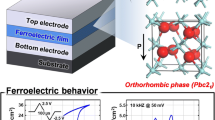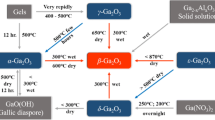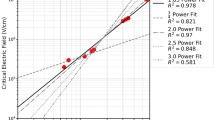Abstract
To study the role of the emitter and collector electrode materials in Ferroelectric Tunnel Junctions (FTJs), an in-depth theoretical investigation of 4 single-barrier FTJs (Pt/BTO/SRO, Pt/BTO/Pt, SRO/BTO/SRO, and SRO/BTO/Pt) is reported. Compared with all known conduction mechanisms in FTJ, it is found that direct quantum tunneling provides the most predominant contribution to the current density in the above systems for the bias range of 0–1.2 V. The lowering of the barrier height and asymmetry in the barrier profile which determines the tunneling current is controlled by the potential drop in the accumulation region in the emitter and the depletion region in the collector which depends on the ratio of screening length, \(\delta\), to permittivity, \(\epsilon\), of the corresponding electrodes. The tunneling electro-resistance ratio (TER) is found to have significant values for bias potential \(V>\left|P\right|\left(\frac{{\delta }_{1}}{{\epsilon }_{1}}+\frac{{\delta }_{2}}{{\epsilon }_{2}}\right)\) wherein the screening charge density \({\sigma }_{s},\) and the net charge density in the barrier layer \(\left({\sigma }_{s}-P\right)\) remain negative resulting in the pull-down of the barrier toward the Fermi level and producing a negative slope in the barrier to increase the tunneling current. Among the studied systems, Pt/BTO/SRO provides the highest TER. Specifically, Pt/24Ǻ BTO/SRO system with an active device length of 5.6 nm is found to have a current density of 2.54 × 104A/cm2 and 1.28 × 102A/cm2 in the ON and OFF state and a TER of nearly 20,000% at the bias of 0.71 V confirming to the necessary conditions of efficient application in memory devices.





Similar content being viewed by others
Data availability
The datasets generated during and/or analyzed during the current study are available from the corresponding author on reasonable request.
References
M.A. Zidan, J.P. Strachan, W.D. Lu, The future of electronics is based on memristive systems. Nat. Electron. 1(1), 22–29 (2018). https://doi.org/10.1038/s41928-017-0006-8
D. Ielmini, H.-S.P. Wong, In-memory computing with resistive switching devices. Nat. Electron. 1(6), 333–343 (2018). https://doi.org/10.1038/s41928-018-0092-2
K.L. Wang, J.G. Alzate, P. KhaliliAmiri, Low-power non-volatile spintronic memory: STT-RAM and beyond. J. Phys. D Appl. Phys. 46(7), 74003 (2013). https://doi.org/10.1088/0022-3727/46/7/074003
J.J. Yang, D.B. Strukov, D.R. Stewart, Memristive devices for computing. Nat. Nanotechnol. 8(1), 13–24 (2013). https://doi.org/10.1038/nnano.2012.240
D. Loke, T.H. Lee, W.J. Wang, L.P. Shi, R. Zhao, Y.C. Yeo, S.R. Elliott, Breaking the speed limits of phase-change memory. Science 336(6088), 1566–1569 (2012). https://doi.org/10.1126/science.1221561
F. Rao, K. Ding, Y. Zhou, Y. Zheng, M. Xia, S. Lv, E. Ma, Reducing the stochasticity of crystal nucleation to enable subnanosecond memory writing. Science 358(6369), 1423–1427 (2017). https://doi.org/10.1126/science.aao3212
D. Apalkov, B. Dieny, J.M. Slaughter, Magnetoresistive random access memory. Proc. IEEE 104(10), 1796–1830 (2016). https://doi.org/10.1109/jproc.2016.2590142
J.-M. Hu, Z. Li, L.-Q. Chen, C.-W. Nan, High-density magnetoresistive random access memory operating at ultralow voltage at room temperature. Nat. Commun. (2011). https://doi.org/10.1038/ncomms1564
T.-C. Chang, K.-C. Chang, T.-M. Tsai, T.-J. Chu, S.M. Sze, Resistance random access memory. Mater. Today 19(5), 254–264 (2016). https://doi.org/10.1016/j.mattod.2015.11.009
V. Garcia, M. Bibes, Ferroelectric tunnel junctions for information storage and processing. Nat. Commun. (2014). https://doi.org/10.1038/ncomms5289
W. Huang, W. Zhao, Z. Luo, Y. Yin, Y. Lin, C. Hou, X.-G. Li, A high-speed and low-power multistate memory based on multiferroic tunnel junctions. Adv. Electron. Mater. 4(4), 1700560 (2018). https://doi.org/10.1002/aelm.201700560
V. Garcia, S. Fusil, K. Bouzehouane, S. Enouz-Vedrenne, N.D. Mathur, A. Barthélémy, M. Bibes, Giant tunnel electroresistance for non-destructive readout of ferroelectric states. Nature 460(7251), 81–84 (2009). https://doi.org/10.1038/nature08128
N. Setter et al., Ferroelectric thin films: review of materials, properties, and applications. J. Appl. Phys. 100, 051606 (2006)
A. Chanthbouala, A. Crassous, V. Garcia, K. Bouzehouane, S. Fusil, X. Moya, Solid-state memories based on ferroelectric tunnel junctions. Nat. Nanotechnol. 7(2), 101–104 (2011). https://doi.org/10.1038/nnano.2011.21
Z. Li, X. Guo, H.-B. Lu, Z. Zhang, D. Song, S. Cheng, W. Zhu, An Epitaxial ferroelectric tunnel junction on silicon. Adv. Mater. 26(42), 7185–7189 (2014). https://doi.org/10.1002/adma.201402527
C. Ma, Z. Luo, W. Huang, L. Zhao, Q. Chen, Y. Lin, X. Li, Sub-nanosecond memristor based on ferroelectric tunnel junction. Nat. Commun. (2020). https://doi.org/10.1038/s41467-020-15249-1
C. Li, L. Huang, T. Li, W. Lü, X. Qiu, Z. Huang, Ultrathin BaTiO3-based ferroelectric tunnel junctions through interface engineering. Nano Lett. 15(4), 2568–2573 (2015). https://doi.org/10.1021/acs.nanolett.5b00138
A. Gruverman, D. Wu, H. Lu, Y. Wang, H.W. Jang, C.M. Folkman, Tunneling electroresistance effect in ferroelectric tunnel junctions at the nanoscale. Nano Lett. 9(10), 3539–3543 (2009). https://doi.org/10.1021/nl901754t
L. Esaki, R.B. Laibowits, P.J. Stiles: 1971 Polar Switch IBM Tech. Discl. Bull 13
P. Gao, Z. Zhang, M. Li, R. Ishikawa, B. Feng, H.-J. Liu, The possible absence of critical thickness and size effect in ultrathin perovskite ferroelectric films. Nat. Commun. 8, 15549 (2017). https://doi.org/10.1038/ncomms15549
Y. Zheng, C.H. Woo, Giant piezoelectric resistance in ferroelectric tunnel junctions. Nanotechnology 20(7), 075401 (2009). https://doi.org/10.1088/0957-4484/20/7/075401
P. Sun, Y.-Z. Wu, T.-Y. Cai, S. Ju, Effects of ferroelectric dead layer on the electron transport in ferroelectric tunneling junctions. Appl. Phys. Lett. 99(5), 052901 (2011). https://doi.org/10.1063/1.3619841
J.D. Burton, E.Y. Tsymbal, Giant tunneling electroresistance effect driven by an electrically controlled spin valve at a complex oxide interface. Phys. Rev. Lett. 106, 15 (2011). https://doi.org/10.1103/physrevlett.106.15720
K.M. Indlekofer, H. Kohlstedt, Simulation of quantum dead-layers in nanoscale ferroelectric tunnel junctions. Europhys. Lett. (EPL) 72(2), 282–286 (2005). https://doi.org/10.1209/epl/i2005-10219-7
N.F. Hinsche, M. Fechner, P. Bose, S. Ostanin, J. Henk, I. Mertig, P. Zahn, Strong influence of complex band structure on tunneling electroresistance: a combined model and initiostudy. Phys. Rev. B 82, 21 (2010). https://doi.org/10.1103/physrevb.82.214110
Y. Zhou, Tunneling magnetoresistance modulation in a magnetic tunnel junction with a ferroelectric barrier. Nanotechnology 22(8), 085202 (2011). https://doi.org/10.1088/0957-4484/22/8/085202
L.L. Tao, J. Wang, Ferroelectricity and tunneling electroresistance effect in asymmetric ferroelectric tunnel junctions. J. Appl. Phys. 119(22), 224104 (2016). https://doi.org/10.1063/1.4953642
X. Luo, Y. Zheng, B. Wang, First-principles calculations of size-dependent giant electroresistance effect in nanoscale asymmetric ferroelectric tunnel junctions. J. Appl. Phys. 111(7), 074102 (2012). https://doi.org/10.1063/1.3698503
D.I. Bilc, F.D. Novaes, J. Íñiguez, P. Ordejón, P. Ghosez, Electroresistance effect in ferroelectric tunnel junctions with symmetric electrodes. ACS Nano 6(2), 1473–1478 (2012). https://doi.org/10.1021/nn2043324
H. Kohlstedt, N.A. Pertsev, J. Rodríguez Contreras, R. Waser, Theoretical current-voltage characteristics of ferroelectric tunnel junctions. Phys. Rev. B 72, 12 (2005). https://doi.org/10.1103/physrevb.72.125341
N.A. Zimbovskaya, Electron transport through asymmetric ferroelectric tunnel junctions: current–voltage characteristics. J. Appl. Phys. 106(12), 124101 (2009). https://doi.org/10.1063/1.3271131
X. Lu, H. Li, W. Cao, Current-voltage characteristics and ON/OFF ratio in ferroelectric tunnel junctions. J. Appl. Phys. 112(5), 054102 (2012). https://doi.org/10.1063/1.4748051
A. Useinov, A. Kalitsov, J. Velev, N. Kioussis, Bias-dependence of the tunneling electroresistance and magnetoresistance in multiferroic tunnel junctions. Appl. Phys. Lett. 105(10), 102403 (2014). https://doi.org/10.1063/1.4895537
J. Wang, S. Ju, Z.Y. Li, Bias voltage effect on electron tunneling across a junction with a ferroelectric–ferromagnetic two-phase composite barrier. J. Magn. Magn. Mater. 324(6), 1067–1070 (2012). https://doi.org/10.1016/j.jmmm.2011.10.024
L.B. Zhang, M.H. Tang, J.C. Li, Y.G. Xiao, Effects of applied bias voltage in tunnel junctions with ferroelectric barrier. Solid-State Electron. 68, 8–12 (2012). https://doi.org/10.1016/j.sse.2011.09.005
Z.J. Ma, G. Chen, P. Zhou, Z.H. Mei, T.J. Zhang, Ferroelectric tunneling under bias voltages. J. Phys. D Appl. Phys. 50(1), 015303 (2016). https://doi.org/10.1088/1361-6463/50/1/015303
J. Li, X. Dong, Y. Chen, Y. Zhang, Space-charge-limited leakage current characteristics influenced by field-dependent permittivity in high dielectric constant and ferroelectric thin films. Appl. Phys. Lett. 88(21), 212905 (2006). https://doi.org/10.1063/1.2203512
R.R. Mehta, B.D. Silverman, J.T. Jacobs, Depolarization fields in thin ferroelectric films. J. Appl. Phys. 44(8), 3379–3385 (1973). https://doi.org/10.1063/1.1662770
N.W. Ashcroft, N.D. Mermin, Solid state physics (Saunders College Publishing, New York, 1976)
D.J. Kim, J.Y. Jo, Y.S. Kim, Y.J. Chang, J.S. Lee, J.-G. Yoon, T.W. Noh, Polarization relaxation induced by a depolarization field in ultrathin ferroelectric BaTiO3 capacitors. Phys. Rev. Lett. (2005). https://doi.org/10.1103/physrevlett.95.237602
P.K. Mahapatra, K. Bhattacharyya, A. Khan, C.L. Roy, Realistic model of Wannier Stark ladders in superlattices. Phys. Rev. B 58(3), 1560–1571 (1998). https://doi.org/10.1103/physrevb.58.1560
P.K. Mahapatra, P. Panchadhyayee, S.P. Bhattacharya, A. Khan, Resonant tunneling in electrically biased multibarrier systems. Phys. B 403(17), 2780–2788 (2008). https://doi.org/10.1016/j.physb.2008.02.008
P. Panchadhyayee, R. Biswas, A. Khan, P.K. Mahapatra, Current density in generalized Fibonacci superlattices under a uniform electric field. J. Phys. Condens. Matter 20(27), 275243 (2008). https://doi.org/10.1088/0953-8984/20/27/275243
L. Xu, T. Wen, X. Yang, C. Xue, J. Xiong, W. Zhang, H.D. Hochheimer, Mesopiezoresistive effects in double-barrier resonant tunneling structures. Appl. Phys.0 Lett. 92(4), 043508 (2008). https://doi.org/10.1063/1.2839316
J. He, Z. Ma, W. Geng, X. Chou, Ferroelectric tunneling through a composite barrier under bias voltages. Mater. Res. Exp. (2019). https://doi.org/10.1088/2053-1591/ab463a
M.-Q. Cai, Y. Zheng, P.-W. Ma, C.H. Woo, Vanishing critical thickness in asymmetric ferroelectric tunnel junctions: first principle simulations. J. Appl. Phys. 109(2), 024103 (2011). https://doi.org/10.1063/1.3532000
Z. Wen, L. You, J. Wang, A. Li, D. Wu, Temperature-dependent tunneling electroresistance in Pt/BaTiO3/SrRuO3 ferroelectric tunnel junctions. Appl. Phys. Lett. 103(13), 132913 (2013). https://doi.org/10.1063/1.4823580
L. Wang, M.R. Cho, Y.J. Shin, J.R. Kim, S. Das, J.-G. Yoon, T.W. Noh, Overcoming the fundamental barrier thickness limits of ferroelectric tunnel junctions through BaTiO3/SrTiO3 composite barriers. Nano Lett. 16(6), 3911–3918 (2016). https://doi.org/10.1021/acs.nanolett.6b01418
Funding
The authors did not receive financial support from any organization for the submitted work.
Author information
Authors and Affiliations
Contributions
All authors contributed to the study, conception, and design. Theoretical formulation, data collection, and analysis were performed by SI, SKS, and PKM. The first draft of the manuscript was written by SI and all authors commented on previous versions of the manuscript. All authors read and approved the final manuscript.
Corresponding author
Ethics declarations
Conflict of interest
We confirm that the authors have no conflicts to disclose.
Ethics approval
No animals or human participants were involved for conducting this research.
Informed consent
All the authors have full consent to the submission of the research work in this journal.
Additional information
Publisher's Note
Springer Nature remains neutral with regard to jurisdictional claims in published maps and institutional affiliations.
Rights and permissions
Springer Nature or its licensor (e.g. a society or other partner) holds exclusive rights to this article under a publishing agreement with the author(s) or other rightsholder(s); author self-archiving of the accepted manuscript version of this article is solely governed by the terms of such publishing agreement and applicable law.
About this article
Cite this article
Ipsita, S., Sahu, S.K. & Mahapatra, P.K. Electrodes: the real performers in single-barrier ferroelectric tunnel junctions. Appl. Phys. A 129, 628 (2023). https://doi.org/10.1007/s00339-023-06887-5
Received:
Accepted:
Published:
DOI: https://doi.org/10.1007/s00339-023-06887-5




